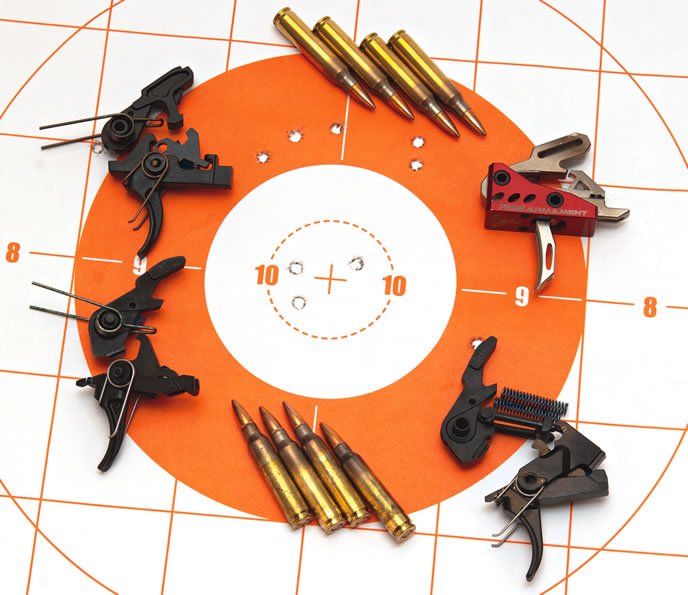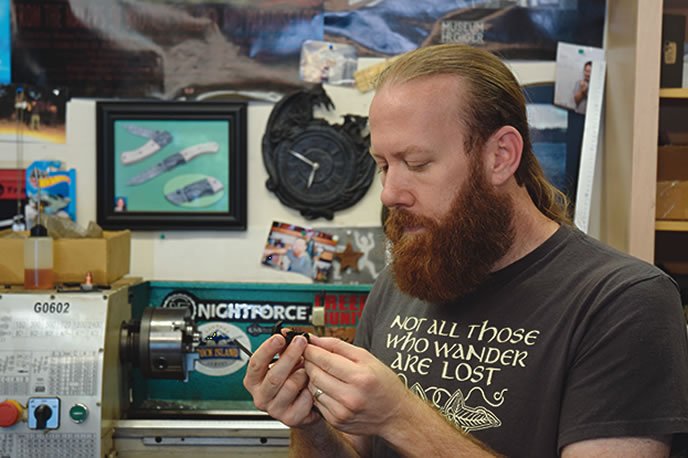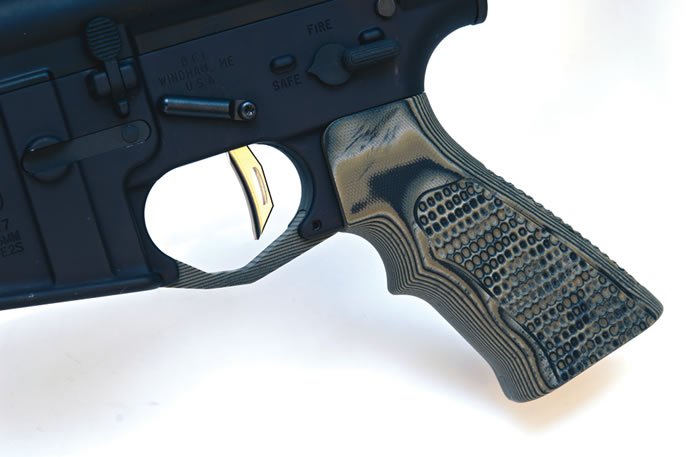Improving the trigger in an AR-15 can make a big difference in performance of the rifle. Whereas handgun triggers are generally retained and modified, the AR-15 lends itself more easily to replacement of its trigger group, such as we did in this review. Our test triggers were two from HiperFire, the $89 HiperTouch EDT AR-15/AR-10 Enhanced Duty Trigger and the $215 HiperTouch 24E Elite, Ruger’s new Elite 452 AR Trigger 90461, $159, and the $259 Rise RA-535 Advanced Performance Trigger.

Our test-bed AR-15 was the Bushmaster “preban” XM-15 carbine previously tested in the August 2003 issue of Gun Tests. The XM-15 featured a 1:9 twist 16-inch-long barrel chambered for 5.56mm ammunition. While its trigger continued to be extremely consistent, the pull weight measured at a full 8.5 pounds with little or no take up and a hard break. In terms of function, there was nothing really to complain about other than it being inordinately heavy, a characteristic we were looking to change. For optics we retained the Sightron S33-4R 1X-magnification red-dot scope that had been in place since about 2005. With four different illuminated reticles to choose from, we picked the single-dot reticle with a size of 2 minutes of angle at 50 yards.

We considered both ease of installation as well as performance in our judging standards. The Rise Armament trigger was a sealed drop-in module, but the other triggers required assembly. By working with both a neophyte builder and an experienced gunsmith, we were able to gain valuable insight on the process. Matt Suddeth of Katy, Texas — a brilliant knife maker with a reputation for exacting rifle work — advised us on aspects of the installation. Once the triggers were configured properly, we measured their pull weights 10 times immediately following installation then 10 more times after our range tests with a Brownells Recording Pull Gauge (174-025-250WB, $125).
Our first test was to make sure the safety remained fully functional. All four triggers passed this test. Then we tried an impact test with the selector in the fire position. With the gun empty, safety off, this consisted of crouching down so that our head was below the line of the muzzle and slamming the buttstock against a concrete floor three times. We wanted to see if we could get the trigger to release the hammer by means other than pulling the trigger. None of the units failed this test. In addition, none of the triggers exhibited common flaws such as creep, grittiness, or dead spots.

Live-fire tests were performed in two segments, each fired offhand (standing unsupported) from the 50-yard line at American Shooting Centers in Houston, Texas. The targets we chose were proprietary to the range, displaying a white 3.9-inch 10-point center containing a 2-inch-diameter X-ring. The 9-point ring consisted of an orange circle, producing an overall diameter of 8 inches. Segment one was a practice session consisting of 50 rounds performed with budget ammunition, American Eagle 5.56×45 55-grain FMJ XM193BLC100, sold in 100-round packaging. During this period, we experimented with different ways the shooter could work the trigger. We fired using the slowest, most controlled press, we could muster. We also moved the trigger fast. We shot strings of fire holding the trigger fully rearward after ignition and then practiced a slow release until the mechanism reset and fired again. We did this as rapidly as we could as well as with measured precision.
After a timed 3-minute rest period, segment two was fired for shots of record using premium ammunition. Limited to ten shots standing unsupported, we chose Black Hills 5.56mm 69-grain OTM (open tip match, featuring the Sierra Match King BTHP bullet). Did any of these triggers make our test gun easier to shoot accurately? Here’s what we found out:
HiperFire HiperTouch EDT AR-15/AR-10 Enhanced Duty Trigger, $89
In terms of construction and operation, the EDT was very much like the trigger it replaced. The feel offered little or no take up and a hard break. The difference was a much lighter pull. But the EDT took time to settle in. The first pull measurements had the Brownells scale jumping from 4.75 pounds to more than 6.0 pounds. We then dry-fired the XM-15 50 times and the trigger began to settle down. Measurements were 5.5, 5.25, 5.5, 5.5, 5.5, 5.5, 5.5, 4.75, 6.0, and 5.25 pounds. After our tests were completed, including impact tests, the trigger registered a constant 5.5 pounds. Installation was straightforward and was slowed only by pushing the support pins far enough to seat the springs in their respective points of retention.
Our Team Said: This was an excellent replacement for the stock trigger in the Bushmaster XM-15. The EDT provided dependable, predictable ignition with less shooter fatigue than the stock trigger.
HiperFire HiperTouch 24E Elite, $215
The defining feature of the HiperTouch 24E was its adjustability. The trigger was controlled by a pair of coil springs (referred to as “toggle” springs by the manufacturer) that ride on struts at the top of the unit. Three pairs of color-coded springs were supplied. The blue toggle springs were meant for medium trigger-pull weight, and the yellow springs were for medium-light pull weight, with both sets providing “low-end stock hammer energy.” The plain-steel color springs were supposed to provide the lightest trigger pull along with a claimed 35% additional hammer energy than stock springs.
Once the support pins were in place, fitting the toggle springs was the only challenge. Once we learned to compress the springs by pushing on the crosspiece and control the pins during disassembly, changing spring weights was actually a very quick process.
We began with the lightest trigger pull and found that it took much less time to settle in to a consistent level of tension than did the EDT. The plain toggle springs resulted in initial variance ranging from 2.5 pounds to 3.0 pounds. By the end of our tests, the trigger-pull gauge registered 2.75 pounds 9 out of 10 times, with one measurement reading 2.85 pounds. The sensation fed back to the shooter was a smooth, even compression.
Changing to the yellow and blue toggle springs, the pull weights increased. The heaviest of the three was the blue, beginning with a 3.5-pound pull on our first try, increasing to 3.75 pounds on our third test pull and jumping to 4.25 pounds on the fourth pull. Three more pulls were measured at 3.75 pounds before the blue spring variant settled in at 3.5 pounds for the rest of our sessions. The yellow springs produced a pull weight of 3.25 pounds on average.
Our Team Said: At the range, we had a difficult time producing satisfactory groups with this trigger. The different spring rates produced different poundages and different sensations of length of pull, if not an actual difference in travel. And as the poundage increased, so did our inability to get a feel for break and reset. The lightest setting would be our first choice, but in our view, it was nevertheless too vague to offer an improvement over the stock trigger.
Ruger Elite 452 AR-Trigger 90461, $160
The Ruger Elite Replacement Trigger comes installed in a demonstration module that looks like it was ripped from an AR-15 lower, including grip and safety mechanism. The unit was reusable, so you can install and test additional trigger components. In addition, both the safety and the grip can be used in a rifle build, so we think this was quite a deal.
Our first measure of trigger-pull weight was about 3.6 pounds and varied no more than about a quarter pound between 3.5 pounds and 3.75 pounds over the course of our first ten tries. After our range sessions, it appeared that a tic more than 3.5 pounds was going to be the norm.
The style of the trigger was a short, free swing and a compression that was not hard but not mushy either. The Ruger Elite Replacement Trigger was very easy to learn, as indicated by the 50-round group on our practice target. Our first two triggers had us trying different approaches to working them, and this was reflected in the broken patterns on our 50-round practice target. It was never our intention to measure our practice target, but when firing with the Ruger trigger in place, the results were quite presentable.
We found the only two ways to approach this trigger was to either use it full time as a short-stroke 2-stage design beginning with take up each time, or to hold the trigger to the rear and release it no further than the reset point. As indicated by our practice target, there was plenty of control and feedback available even if you alternated between the two methods. Law-enforcement personnel that we regularly team with prefer some measure of take up, so if a shot is not needed, it is easier to safely back off the trigger.
Our Team Said: This was a highly competent design that splits the difference between single-stage and two-stage triggers.
Rise RA-535 Advanced Performance Trigger, $259
The unit was a true drop-in component. The Rise RA-535 Trigger Group was a sealed module consisting of a red-anodized aluminum frame holding the hammer, trigger, and springs in line and ready to work. All that was required was the removal of the safety to drop it into place. The hammer and trigger rode seated on hollow tubes, so mounting required the use of non-rotating pins. Rise delivers the RA-535 with a very nice set of KNS non-rotating pins, including a brass guide. Non-rotating pins are traditionally used to prevent the pins from burrowing out the diameter of the holes in the relatively soft aluminum frame. But in this case, they were being used to connect the brackets running along the outside of the lower rifle frame.
No instructions were supplied, nor could we find any on the RiseArmament.com website. The trigger pin was threaded at each end of its inner diameter with Torx screws supplied to pull the brackets together. The hammer pin was machined to fit into the slots machined into the interior surface at the other end of the bracket. But in this case the pins merely lent support so their positions supporting the hammer or the trigger was interchangeable.
The trigger and hammer were finished with bright stainless plating, making the Rise unit far more attractive than more typical components. The contour of the trigger was nearly straight. We found the surface of the trigger to be noticeably rounded and a little slippery, too. Our first 10 measurements of the trigger began with a 5.0-pound pull. Variation ranged from 4.25 pounds to 5.25 pounds before settling down to a steady 4.75 pounds, despite being advertised as providing a. 3.5-pound trigger pull. Further description on the website reads, “With a crazy-fast reset, nearly nonexistent over-travel, and a smoother, crisper, lighter trigger pull, the RA-535 Advanced Performance Trigger (APT) helps you fire more quickly and accurately. The single-stage trigger group is easy to install.” Despite measuring heavier than the claimed 3.5-pound trigger-pull weight, we thought the press was quite clean and its reset was very quick indeed.
At the range, our 50-round practice target showed very good accuracy. Then in our final record 10-shot string, we began to experience unintentional discharges. On the third press of the string, the gun fired twice but stopped, failing to feed the next round.
We cleared the jammed round and refilled the chamber. Shooting carefully with a solid grip, we pressed the trigger. But instead of a single shot, the result was a three-round burst. Judged as unsafe, this concluded our firing session. Off the range, the empty gun was retested for impact and manually tested for its ability to return to reset. The RA-535 passed both of these tests on an empty chamber.
Working the bolt manually, the trigger safely reset each time. But the reset did seem to be quite minimal in retention. We remeasured the trigger press and saw the results matched our initial findings, 4.5 to 4.75 pounds on average. But the distance to reset was by far the shortest among our test triggers and probably the shortest of any trigger on a semi-automatic carbine we’ve seen to date. When we removed it for further inspection, we found that the plating on the face of the hammer was peeling off.
Our Team Said: Ease of installation was probably this unit’s strongest point. Trigger compression was clean and short, if not as light as advertised. Plating on the hammer face peeled after a relatively short firing session. As a result of that and the unintentional discharges we experienced, we would not buy the Rise RA-535.
Written by Roger Eckstine, using evaluations from Gun Tests team testers. GT


























